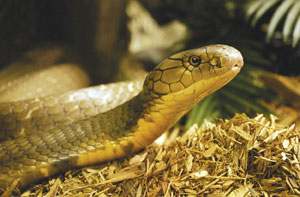 |
Tarai residents must think we are wimps because we worry about leech bites in the summer. Imagine how much more frightening and deadly a snake bite is. Conservative estimates suggest that there are about 20, 000 snake bites and 1000 fatalities, almost all in the Tarai.
Unfortunately, since snake bites primarily affect the impoverished, prevention and medical management of snake bites have been neglected. Furthermore, there is a shortage of information. For example, many Nepali doctors will consult Western textbooks to treat snake bites. But treatment of pit viper snake bite from the Sonoran desert in Arizona, USA (which are usually what are discussed in Western textbooks) is going to be significantly different than Nepali snake bites. Russell's vipers, kraits and cobras are the three well-recognised types of venomous snakes in Nepal. While kraits and cobras cause more neurological and breathing problems, viper bites seem to cause acute kidney or blood problems.
Dr Sanjib Sharma, who has published extensively on snake bites in Nepal in international medical journals, has shown that prompt transfer of victims to proper healthcare centres on the back of motorbikes can help save lives. Dr Sharma has trained healthcare professionals to administer anti-snake venom (when available) and provide artificial ventilation when necessary.
Offering rewards for killing venomous snakes has been used as a method of preventing snake bites, but the ecological impact may be detrimental as snakes keep the rodent population in check and help with agriculture. Knowing the behavioural patterns of snakes is a more useful preventive method. The kraits in the Tarai seem to bite mostly at night when people are sleeping on the floors. Sleeping above ground level will obviously help. Using mosquito nets has also shown to be effective against snake bites in the Tarai. Most snakes bite on the feet and legs while farmers work in their fields. Indeed Russell's vipers are so common in paddy fields that it is imperative for farmers to always wear proper foot gear. Carrying torch lights or lamps at night will be helpful. Simple measures like these will go a long way in preventing snake bites.


